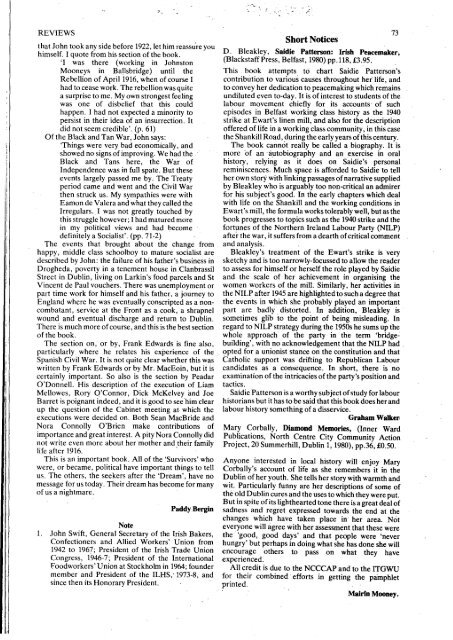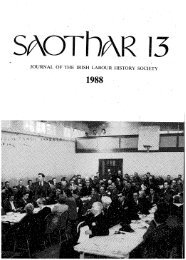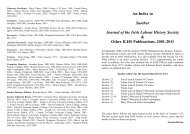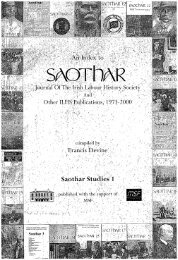Iris an Chumainn le Stair Lucht Saothair na hEireann Journal of the ...
Iris an Chumainn le Stair Lucht Saothair na hEireann Journal of the ...
Iris an Chumainn le Stair Lucht Saothair na hEireann Journal of the ...
Create successful ePaper yourself
Turn your PDF publications into a flip-book with our unique Google optimized e-Paper software.
REVIEWS<br />
that John took <strong>an</strong>y side before 1922, <strong>le</strong>t him reassure you<br />
himself. I quote from his section <strong>of</strong> <strong>the</strong> book.<br />
'I was <strong>the</strong>re (working in 10hnston<br />
Mooneys in Ballsbridge) until <strong>the</strong><br />
Rebellion <strong>of</strong> April 1916, when <strong>of</strong> course I<br />
had to cease work. The rebellion was quite<br />
a surprise to me. My own strongest feeling<br />
was one <strong>of</strong> disbelief that this could<br />
happen. I had not expected a minority to<br />
persist in <strong>the</strong>ir idea <strong>of</strong> <strong>an</strong> insurrection. It<br />
did not seem credib<strong>le</strong>'. (p. 61)<br />
Of <strong>the</strong> Black <strong>an</strong>d T<strong>an</strong> War, John says:<br />
Things were very bad economically, <strong>an</strong>d<br />
showed no signs <strong>of</strong> improving. We had <strong>the</strong><br />
Black <strong>an</strong>d T<strong>an</strong>s here, <strong>the</strong> War <strong>of</strong><br />
Independence was in full spate. But <strong>the</strong>se<br />
events largely passed me by. The Treaty<br />
period came <strong>an</strong>d went <strong>an</strong>d <strong>the</strong> Civil War<br />
<strong>the</strong>n struck us. My sympathies were with<br />
Eamon de Va<strong>le</strong>ra <strong>an</strong>d what <strong>the</strong>y cal<strong>le</strong>d <strong>the</strong><br />
Irregulars. I was not greatly touched by<br />
this strugg<strong>le</strong> however; I had matured more<br />
in my political views <strong>an</strong>d had become<br />
definitely a Socialist'. (pp. 71-2)<br />
The events that brought about <strong>the</strong> ch<strong>an</strong>ge from<br />
happy, midd<strong>le</strong> class schoolboy to mature socialist are<br />
described by John: <strong>the</strong> failure <strong>of</strong> his fa<strong>the</strong>r's business in<br />
Drogheda, poverty in a tenement house in.Cl<strong>an</strong>brassil<br />
Street in nublin, living on Larkin's food parcels <strong>an</strong>d St<br />
Vincent de Paul vouchers. There was unemployment or<br />
part time work for himself <strong>an</strong>d his fa<strong>the</strong>r, a journey to<br />
Engl<strong>an</strong>d where he was eventually conscripted as a noncombat<strong>an</strong>t,<br />
service at <strong>the</strong> Front as a cook, a shrapnel<br />
wound <strong>an</strong>d eventual discharge <strong>an</strong>d return to Dublin.<br />
There is much more <strong>of</strong> course, <strong>an</strong>d this is <strong>the</strong> best section<br />
<strong>of</strong> <strong>the</strong> book.<br />
The section on, or by, Fr<strong>an</strong>k Edwards is fine also,<br />
particularly where he relates his experience <strong>of</strong> <strong>the</strong><br />
Sp<strong>an</strong>ish Civil War. It is not quite c<strong>le</strong>ar whe<strong>the</strong>r this was<br />
written by Fr<strong>an</strong>k Edwards or by Mr. MacEoin, but it is<br />
certainly import<strong>an</strong>t. So also is <strong>the</strong> section by Peadar<br />
O'Donnell. His description <strong>of</strong> <strong>the</strong> execution <strong>of</strong> Liam<br />
Mellowes, Rory O'Connor, Dick McKelvey <strong>an</strong>d Joe<br />
Barret is poign<strong>an</strong>t indeed, <strong>an</strong>d it is good to see'him c<strong>le</strong>ar<br />
up <strong>the</strong> question <strong>of</strong> <strong>the</strong> Cabinet meeting at which <strong>the</strong><br />
executions were decided on. Both Se<strong>an</strong> MacBride <strong>an</strong>d<br />
Nora Connolly O'Brien make contributions <strong>of</strong><br />
import<strong>an</strong>ce <strong>an</strong>d great interest. A pity Nora Connolly did<br />
not write even more about her mo<strong>the</strong>r <strong>an</strong>d <strong>the</strong>ir family<br />
life after 1916. .<br />
This is <strong>an</strong> import<strong>an</strong>t book. All <strong>of</strong> <strong>the</strong> 'Survivors' who<br />
were, or became, political have import<strong>an</strong>t things to tell<br />
us. The o<strong>the</strong>rs, <strong>the</strong> seekers after <strong>the</strong> 'Dream', have no<br />
message for us today. Their dream has become for m<strong>an</strong>y<br />
<strong>of</strong> us a nightmare.<br />
Paddy Bergin<br />
Note<br />
1. John Swift, General Secretary <strong>of</strong> <strong>the</strong> <strong>Iris</strong>h Bakers,<br />
Confectioners <strong>an</strong>d Allied Workers' Union from<br />
1942 to 1967; President <strong>of</strong> <strong>the</strong> <strong>Iris</strong>h Trade Union<br />
Congress, 1946-7; President <strong>of</strong> <strong>the</strong> Inter<strong>na</strong>tio<strong>na</strong>l<br />
foodworkers' Union at Stockholm in 1964; founder<br />
member <strong>an</strong>d President <strong>of</strong> <strong>the</strong> ILHS,' 1973-8, <strong>an</strong>d<br />
since <strong>the</strong>n its Honorary President.<br />
Short Notices<br />
D. B<strong>le</strong>ak<strong>le</strong>y, Saidie Patterson: <strong>Iris</strong>h Peacemaker,<br />
(BlackstaffPress, Belfast, 1980) pp.118, £3.95.<br />
This book attempts to chart Saidie Patterson's<br />
contribution to various causes throughout her life, <strong>an</strong>d<br />
to convey her dedication to peacemaking which remains<br />
undiluted even to-day. It is <strong>of</strong> interest to students <strong>of</strong> <strong>the</strong><br />
labour movement chiefly for its accounts' <strong>of</strong> such<br />
episodes in Belfast working class history as <strong>the</strong> 1940<br />
strike at Ewart's linen mill, <strong>an</strong>d also for <strong>the</strong> description<br />
<strong>of</strong>fered <strong>of</strong> life in a working class community, in this case<br />
<strong>the</strong> Sh<strong>an</strong>kill Road, during <strong>the</strong> early years <strong>of</strong> this century.<br />
The book c<strong>an</strong>not really be cal<strong>le</strong>d a biography. It is<br />
more '<strong>of</strong> <strong>an</strong> . autobiography <strong>an</strong>d <strong>an</strong> exercise in oral<br />
history, relying as it does on Saidie's perso<strong>na</strong>l<br />
reminiscences. Much space is afforded to Saidie to tell<br />
her own story with linking passages <strong>of</strong> <strong>na</strong>rrative supplied<br />
by B<strong>le</strong>ak<strong>le</strong>y who is arguably too non-critical <strong>an</strong> admirer<br />
for his subject's good. In <strong>the</strong> early chapters which deal<br />
with life on <strong>the</strong> Sh<strong>an</strong>kill <strong>an</strong>d <strong>the</strong> working conditions in<br />
Ewart's mill, <strong>the</strong> formula works to<strong>le</strong>rably well, but as <strong>the</strong><br />
book progresses to topics such as <strong>the</strong> 1940 strike <strong>an</strong>d <strong>the</strong><br />
fortunes <strong>of</strong> <strong>the</strong> Nor<strong>the</strong>rn Irel<strong>an</strong>d Labour Party (NILP)<br />
after <strong>the</strong> war, it suffers from a dearth <strong>of</strong> critical comment<br />
<strong>an</strong>d <strong>an</strong>alysis.<br />
B<strong>le</strong>ak<strong>le</strong>y's treatment <strong>of</strong> <strong>the</strong> Ewart's strike is very<br />
sketchy <strong>an</strong>d is too <strong>na</strong>rrowly-focussed to allow <strong>the</strong> reader<br />
to assess for himself or herself <strong>the</strong> ro<strong>le</strong> played by Saidie<br />
<strong>an</strong>d <strong>the</strong> sca<strong>le</strong> <strong>of</strong> her achievement in org<strong>an</strong>ising <strong>the</strong><br />
women workers <strong>of</strong> <strong>the</strong> mill. Similarly, her activities in<br />
<strong>the</strong> NILP after 1945 are highlighted to such a degree that<br />
<strong>the</strong> events in which she probably played <strong>an</strong> import<strong>an</strong>t<br />
part are badly distorted. In addition, B<strong>le</strong>ak<strong>le</strong>y is<br />
sometimes glib to <strong>the</strong> point <strong>of</strong> being mis<strong>le</strong>ading. In<br />
regard to NILP strategy during <strong>the</strong> 1950s he sums up <strong>the</strong><br />
who<strong>le</strong> approach <strong>of</strong> <strong>the</strong> party in <strong>the</strong> term 'bridgebuilding',<br />
with no acknow<strong>le</strong>dgement that <strong>the</strong> NILP had<br />
opted for a unionist st<strong>an</strong>ce on <strong>the</strong> constitution <strong>an</strong>d that<br />
Catholic support was drifting to Republic<strong>an</strong> Labour<br />
c<strong>an</strong>didates as a consequence. In short, <strong>the</strong>re is no<br />
exami<strong>na</strong>tion <strong>of</strong> <strong>the</strong> intricacies <strong>of</strong><strong>the</strong> party's position <strong>an</strong>d<br />
tactics.<br />
Saidie Patterson is a worthy subject <strong>of</strong> study for labour<br />
histori<strong>an</strong>s but it has to be said that this book does her <strong>an</strong>d<br />
labour history something <strong>of</strong> a disservice.<br />
Grabam Walker,<br />
Mary Corbally, Diamond Memories, (Inner Ward<br />
Pub.lications, North Centre City Community Action<br />
Project, 20 Summerhill, Dublin 1, 1980), pp.36, £0.50.<br />
Anyone interested in local history will enjoy Mary<br />
Corbally's account <strong>of</strong> life as she remembers it in <strong>the</strong><br />
Dublin <strong>of</strong> her youth. She tells her story with warmth <strong>an</strong>d<br />
wit. Particularly funny are her descriptions <strong>of</strong> some <strong>of</strong><br />
<strong>the</strong> old Dublin cures <strong>an</strong>d <strong>the</strong> uses to which <strong>the</strong>y were put.<br />
But in spite <strong>of</strong> its ligh<strong>the</strong>arted tone <strong>the</strong>re is a great deal <strong>of</strong><br />
sadness <strong>an</strong>d regret expressed towards <strong>the</strong> end at <strong>the</strong><br />
ch<strong>an</strong>ges which have taken place in her area. Not<br />
everyone will agree with her assessment that <strong>the</strong>se were<br />
<strong>the</strong> 'good, good days' <strong>an</strong>d that peop<strong>le</strong> were 'never<br />
hungry' but perhaps in doing what she has done she will<br />
encourage o<strong>the</strong>rs to pass on what <strong>the</strong>y have<br />
experienced.<br />
All credit is due to <strong>the</strong> NCCCAP <strong>an</strong>d to <strong>the</strong> ITGWU<br />
for <strong>the</strong>ir combined efforts in getting <strong>the</strong> pamph<strong>le</strong>t<br />
printed.<br />
Mairfn Mooney.<br />
73





